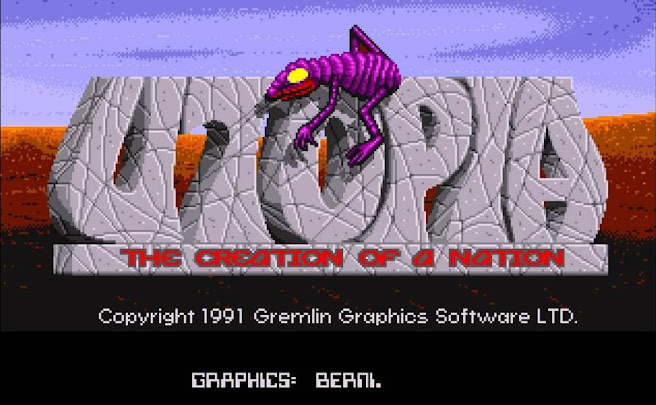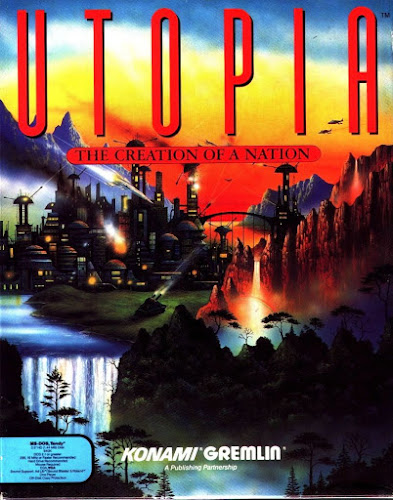“Space: the final frontier“. I’m sure everyone knows this quote. Outer space has always been the ultimate destination of any population, to create new civilisations in new, alien worlds. So much so that space colony management sims could almost be considered its own sci-fi subgenre. So, today we’ll be reviewing Utopia: The Creation of a Nation.
Utopia: The Creation of a Nation is a managerial/strategy game developed by Celestial Software and published by Gremlin. It was originally released in 1991 for the Amiga and Atari ST. It was released the following year for DOS and in 1993, it was ported for the SNES/Super Famicom in the US and Japan. In 1994, it was released for the Super Nintendo in the EU and in 1995, it was re-released for DOS in CD-ROM format.
But as always, let’s look at the covers:
I also hate noisy neighbors.
As you can see, this European cover depicts a futuristic city under attack in the background and in the foreground, some apparently alien flora and fauna. I particularly like the contrast of the peaceful nature elements vs. the warlike sci-fi technology. And I also like the title art and the variety of colours.
This is the US cover and as you can see, it focus a bit more on the futuristic city. The forest and mountains around it don’t look alien anymore, but it maintains the same contrast as the previous cover, albeit perhaps a bit more nuanced now.
“So, what you guys think of my new HD TV?”
This is the PAL Super Nintendo cover and as you can see, it again shows the futuristic city in the background but now with a robot, an alien and some guy in the foreground. It might give away the idea that this is a sci-fi war game of some kind, when in truth it has more elements than that.
This is the NTSC SNES cover and it only shows a cropped up vision of the city. Pretty lame in comparison with the previous covers, in my opinion.
Anyway, it’s time to boot this sucker:
As you can see, the game starts with a title screen featuring the gorgeous title art from the EU computer cover and a beautiful rendition of Pachelbel’s Canon. Then we go immediately to the main menu where we can start a new game by choosing a scenario, play through a tutorial (basically an easier scenario to get our feet wet, so to speak), load or save a game, or go through the game’s options.
However, I recommend reading the manual before playing the game because it not only features a good dramatisation that’ll help the immersion, but it also explains every single game icon and every building and feature in the game. I also recommend to try the tutorial first to get a good idea of the gameplay if you’re not used to this genre.
When starting a new scenario (or the tutorial), you’ll get a UI very reminiscent of Populous: a main screen in a isometric angle, with a directional pad (for navigation) and several icons on the left side, and above, some information pertaining the current date, credits available and the Quality of Life.
Your colony also starts with some buildings already built: usually the Command Centre (the most important building in the game), some residential buildings and little more. The objective is to ensure your colony’s survival and raise the Quality of Life to at least 80% by researching and building new facilities, each with its own function.
And although you can count with a stipend from your world planet at the beginning, it’s only temporary and you have to figure out how can your colony become self-sufficient and later on, prosperous. You’ll also need to learn how to produce your own oxygen, food and technology and grow your colony without losing any resources and credits.
Eventually, when exploring the planet, you’ll encounter another alien race, who’s also colonising it. So now you must research and build your military forces to defend your colony and attack the other race’s colony. Luckily, you can invest in Intelligence spies to locate the enemy colony and determine their technology level and military power.
And in case you’re ever lost and don’t know how to progress, you have access to a council of 6 experts that’ll recommend you (or warn you) the best course of action in each different aspect of the colony (technology level, citizens’ wellbeing, finances, military power, etc.)
And after finishing the tutorial (or until you think you’ve grasped the gameplay basics), you can go back to the main menu and choose another scenario to play, which features another planet to colonise and a different enemy race to contend with.
Now with the technical aspects. The graphics are okay for the time, with some small sprites but with good animation and colours. The sound effects are almost non-existent but the music tracks (all 4 of them) are actually quite good. The mouse control is also pretty good and although you can also use a joystick, this kind of gameplay is perfect for mouse devices.
In conclusion, Utopia might appear like a SimCity clone with combat elements at 1st glance, but it’s actually a pretty solid game. It might not have the depth of other strategy/managerial titles, but it definitely holds its own. To the fans of the genre, I recommend it. To beginners though, give it a shot.
And you can play in your own browser right here. The game had some success (enough for 2 sequels) and developed a small cult following.
The Amiga version looks exactly alike but it adds the dramatisation from the manual as an introduction cutscene. I haven’t played the other versions but the Super Nintendo/SNES and Atari ST versions are popular.
In 1992, a scenario add-on, called The New Worlds, was released for the Amiga, Atari ST and DOS. It features 10 new planets and enemy races, including humans (called Terrans ingame). It was succeeded in 1994 by K240 (for the Amiga only) and in 1997 by Fragile Allegiance (for Windows, DOS and Linux).
Well, I hope you’ve enjoyed the review and I hope you’re handling these rough times well.
Next time, we’re going to take a look at a popular and beloved character that so far, has never been well adapted to video games. Until then, keep on playing.
Links :1) My Reviews 2) Twitter










No comments:
Post a Comment
Please read before commenting : ((ENGLISH ONLY)) Constructive criticism allowed, but nasty comments will be removed and IP banned! Banned users will not show up in my comment feed - Play nice, and enjoy IndieRetroNews! :)